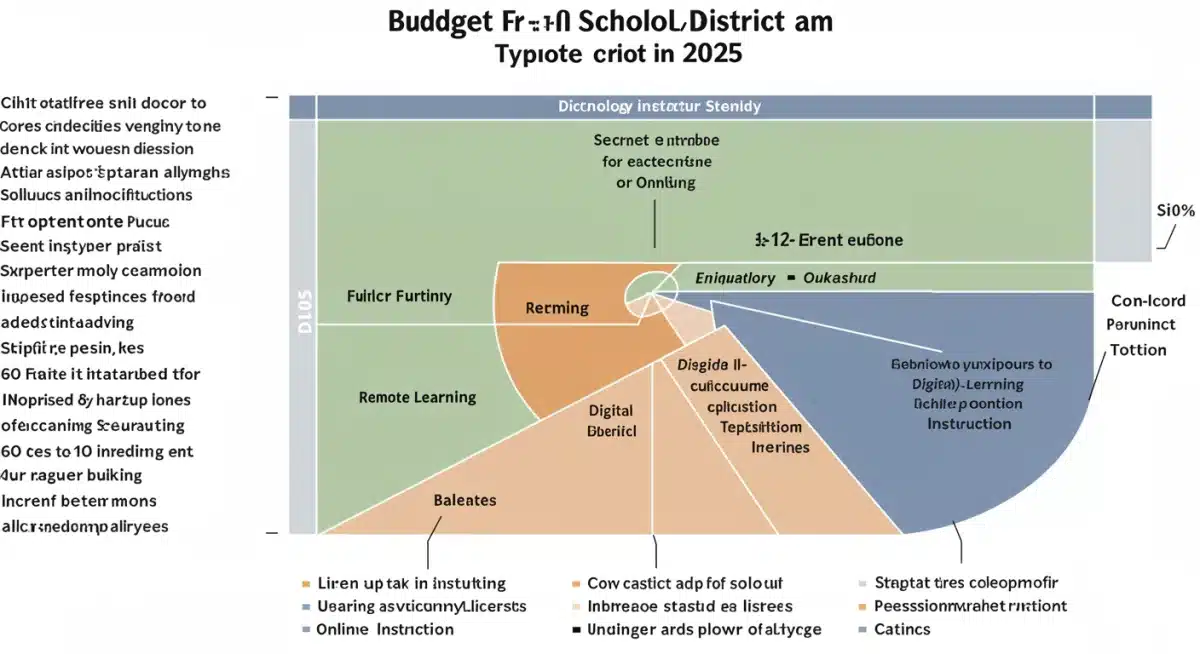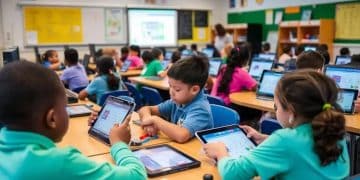Remote Learning Financial Impact: K-12 Districts 2025 Analysis

The financial impact of remote learning trends on K-12 school districts in the U.S. for 2025 is a complex landscape, necessitating strategic budget reallocations to accommodate technology infrastructure, professional development, and equitable access for all students.
As we approach 2025, understanding the financial impact of remote learning trends on K-12 school districts in the U.S. has become more critical than ever. The rapid shift to digital education, accelerated by recent global events, has fundamentally reshaped how schools operate and allocate resources. This analysis delves into the economic realities and strategic considerations facing districts nationwide as they navigate this evolving educational landscape.
Shifting budget priorities in a digital era
The transition to remote and hybrid learning models has fundamentally altered the financial priorities of K-12 school districts. What was once considered supplementary technology spending has now become a core operational expense, demanding significant reevaluation of traditional budget allocations.
Districts are grappling with the need to invest heavily in digital infrastructure while balancing existing commitments. This often means diverting funds from areas like physical facilities maintenance or traditional classroom supplies, highlighting a paradigm shift in educational resource management.
Technology infrastructure and hardware investments
A primary area of increased expenditure is robust technology infrastructure. Reliable internet access, learning management systems, and cybersecurity measures are no longer luxuries but necessities for effective remote instruction.
- Purchasing and maintaining student devices (laptops, tablets)
- Upgrading school network bandwidth and Wi-Fi capabilities
- Investing in secure cloud-based learning platforms
- Implementing advanced cybersecurity protocols
These investments are continuous, requiring ongoing maintenance and upgrades to keep pace with technological advancements and evolving educational needs. Districts must forecast these costs accurately to avoid future budget shortfalls.
Digital curriculum and software licenses
Beyond hardware, the cost of digital curriculum and software licenses represents another substantial financial commitment. Traditional textbooks are being replaced or supplemented by interactive digital content, requiring annual subscriptions and specialized training for educators.
The selection of appropriate digital resources involves careful consideration of pedagogical effectiveness, accessibility, and cost-efficiency. Districts often seek platforms that offer comprehensive solutions for various subjects and grade levels.
In conclusion, the shift in budget priorities reflects a fundamental transformation in educational delivery. Districts must strategically reallocate funds, prioritizing technology and digital resources to support effective remote and hybrid learning environments, ensuring sustained investment in these critical areas.
The cost of equitable access and digital divide
Ensuring equitable access to remote learning remains a significant financial challenge for K-12 districts across the U.S. The digital divide, which exposes disparities in internet access and device availability, directly impacts a district’s budget as they strive to provide all students with the tools needed for success.
Addressing this gap requires targeted investments and creative solutions, often putting a strain on already stretched financial resources. Districts must consider the unique needs of their student populations, including those from low-income households or rural areas.
Bridging the connectivity gap
Many districts have taken on the responsibility of providing internet access to students who lack it at home. This can involve distributing mobile hotspots, negotiating bulk internet plans, or even establishing community Wi-Fi networks.
- Providing subsidized internet services for eligible families
- Distributing portable Wi-Fi hotspots for home use
- Partnering with local internet service providers for discounted rates
These initiatives, while vital for educational equity, come with considerable recurring costs. Districts need sustainable funding models to maintain these services long-term.
Device provision and maintenance
Beyond connectivity, ensuring every student has a functional learning device is paramount. Districts have invested heavily in one-to-one device programs, providing laptops or tablets to all students. However, the initial purchase is only part of the expense.
Maintenance, repair, and replacement of these devices add ongoing financial pressure. Technical support staff, troubleshooting services, and insurance for devices are all necessary components of a comprehensive device program.
Ultimately, the pursuit of equitable access is a moral imperative with substantial financial implications. Districts must continue to allocate resources to overcome the digital divide, recognizing that these investments are foundational to student success in a remote learning environment.
Professional development for remote instruction
The effectiveness of remote learning hinges significantly on the preparedness and skill set of educators. Consequently, professional development for remote instruction has emerged as a crucial, and often costly, investment for K-12 school districts.
This goes beyond basic technology training; it involves equipping teachers with pedagogical strategies tailored for online environments, fostering digital citizenship, and understanding how to engage students effectively without direct physical presence. Districts recognize that without this investment, the advanced technology infrastructure would be underutilized.
Designing engaging online curricula
Teachers require specialized training to adapt traditional lesson plans into engaging and interactive digital formats. This includes mastering various online collaboration tools, multimedia creation, and assessment strategies suitable for remote settings.
Workshops and ongoing coaching help educators develop expertise in:
- Utilizing learning management systems efficiently
- Creating interactive digital assignments
- Implementing virtual classroom management techniques
- Assessing student progress in online environments
These skills are fundamental to maintaining instructional quality and student engagement in a remote or hybrid model.
Supporting teacher well-being and digital literacy
Beyond technical skills, professional development also addresses the well-being of educators, acknowledging the increased demands of remote teaching. Training often includes strategies for managing screen time, preventing burnout, and fostering a healthy work-life balance.
Furthermore, digital literacy for teachers extends to understanding data privacy, online safety, and effective communication with parents in a virtual context. These aspects are critical for maintaining a secure and supportive learning ecosystem.
In summary, investing in comprehensive professional development is essential for maximizing the return on technology investments and ensuring high-quality remote instruction. It empowers educators to adapt and thrive in the evolving educational landscape, directly impacting student outcomes.
Operational efficiencies and unexpected costs
While remote learning introduces significant new expenses, it also presents opportunities for operational efficiencies in some areas for K-12 school districts. However, these efficiencies are often offset by unexpected costs, creating a complex financial picture that requires careful analysis and strategic planning.
Districts must continually adapt their operational models to leverage potential savings while preparing for unforeseen expenditures associated with digital education. This delicate balance is key to fiscal stability in 2025 and beyond.
Potential savings and reallocations
Remote learning can lead to reduced costs in certain operational categories. For instance, decreased utility consumption in physical buildings, lower transportation expenses due to fewer bus routes, and reduced expenditures on some physical classroom supplies can offer some financial relief.
These savings can then be reallocated to fund critical technology initiatives or professional development programs. The key is to identify genuine, sustainable savings rather than temporary reductions.
Emerging and hidden costs
Conversely, remote learning often brings a host of emerging and hidden costs that can quickly deplete budgets. These include:
- Increased IT support staff and services
- Expanded data storage and cloud computing fees
- Licensing for specialized remote learning software
- Costs associated with ensuring digital accessibility for students with disabilities
- Enhanced cybersecurity measures and incident response
Furthermore, there can be indirect costs, such as the need for additional counseling and mental health support for students and staff navigating the challenges of remote learning, which can impact overall district budgets.
The financial landscape of remote learning is characterized by a dynamic interplay of savings and expenditures. Districts must proactively identify and manage both, developing flexible budgets that can respond to the evolving demands of digital education.
Impact on student enrollment and funding models
The financial impact of remote learning trends extends beyond direct operational costs to influence student enrollment patterns and, consequently, state and federal funding models for K-12 school districts. Enrollment fluctuations directly affect per-pupil funding, which forms the bedrock of most district budgets.
As remote learning options become more prevalent, districts may experience shifts in student populations, necessitating a reevaluation of how funding is allocated and how to maintain financial stability in a changing educational market.
Enrollment shifts and per-pupil funding
Some families have opted for homeschooling or virtual charter schools in response to remote learning offerings, leading to potential enrollment declines in traditional public school districts. This directly impacts per-pupil funding, which is often tied to student attendance and registration numbers.
Districts with declining enrollment face the challenge of maintaining services with reduced revenue, potentially leading to difficult decisions regarding staffing and program offerings.
Adapting funding formulas for hybrid models
Existing funding formulas, largely designed for in-person instruction, may not adequately account for the nuances and costs associated with hybrid or fully remote learning models. There is a growing call for states to adapt these formulas to reflect the realities of digital education.
Considerations for new funding models include:
- Funding for technology infrastructure and digital resources
- Support for internet access for all students
- Additional resources for professional development in remote instruction
- Flexibility for districts offering diverse learning modalities
Advocating for legislative changes to funding mechanisms is crucial for districts to secure adequate resources for their evolving educational landscapes. The financial health of districts in 2025 will increasingly depend on their ability to adapt to and influence these funding models.
Strategic planning for sustainable remote learning
For K-12 school districts, strategic planning is paramount for developing sustainable remote learning models that are both effective and fiscally responsible. This involves a long-term vision that integrates technology, pedagogy, and financial foresight, moving beyond reactive measures to proactive solutions.
Districts must engage stakeholders, analyze data, and forecast future needs to build resilient educational systems. The goal is to create remote learning environments that are not only financially viable but also enhance educational outcomes for all students.
Long-term technology roadmaps
Developing a multi-year technology roadmap is essential. This roadmap should outline planned investments in hardware, software, and infrastructure, ensuring that technology purchases are aligned with instructional goals and budget cycles.

Key components of a technology roadmap include:
- Regular refresh cycles for student and teacher devices
- Planned upgrades for network capacity
- Ongoing evaluation and selection of digital learning platforms
- Strategic partnerships with technology vendors
Such a roadmap helps districts anticipate costs and allocate funds more effectively, avoiding last-minute, expensive emergency purchases.
Collaborative funding and resource sharing
Exploring collaborative funding opportunities and resource-sharing models can significantly alleviate financial burdens. This might involve:
- Applying for federal grants specifically for education technology
- Partnering with local businesses or non-profits for device donations
- Sharing digital curriculum licenses with neighboring districts
- Creating regional hubs for IT support and professional development
These collaborative efforts can maximize resources and foster a more robust ecosystem for remote learning across communities. By thinking proactively and engaging in strategic partnerships, districts can build sustainable remote learning programs that meet the evolving needs of their students and educators.
| Key Financial Area | 2025 Impact & Trend |
|---|---|
| Technology Infrastructure | Significant increase in spending for devices, internet, and cybersecurity. |
| Equitable Access | Ongoing costs for bridging the digital divide through device and internet provision. |
| Professional Development | Continuous investment in training educators for effective remote pedagogy. |
| Funding Models | Pressure to adapt per-pupil funding to reflect remote and hybrid learning costs. |
Frequently asked questions about remote learning’s financial impact
Primary new costs include significant investments in technology infrastructure such as devices, internet access for students, learning management systems, and robust cybersecurity. Additionally, digital curriculum licenses and comprehensive professional development for teachers in online pedagogy are major expenditures.
Districts address the digital divide by allocating funds for student device provision, distributing mobile hotspots, and sometimes subsidizing internet access for low-income families. These efforts aim to ensure all students have the necessary tools and connectivity for remote learning, requiring sustained budget commitments.
Remote learning can offer some savings in areas like reduced utility costs for physical buildings, lower transportation expenses, and less need for certain physical classroom supplies. However, these are often offset by new and increased expenditures in technology, professional development, and equitable access initiatives.
Remote learning can cause shifts in student enrollment, directly affecting per-pupil funding, which is a major revenue source for districts. There’s also growing pressure to adapt traditional funding formulas to better account for the unique costs associated with hybrid and fully remote instructional models.
Sustainable financial planning involves developing long-term technology roadmaps, proactively budgeting for infrastructure and staff training, and exploring collaborative funding models. Districts can seek grants, form partnerships, and share resources to maximize efficiency and ensure long-term viability of remote learning programs.
Conclusion
The financial impact of remote learning trends on K-12 school districts in the U.S. for 2025 is clearly multifaceted, demanding continuous adaptation and strategic foresight. Districts must navigate increased expenditures in technology infrastructure, digital curriculum, and professional development while simultaneously addressing the persistent challenge of equitable access. While some operational efficiencies may emerge, they are often balanced by new and unexpected costs. The evolving educational landscape necessitates a proactive approach to budgeting, innovative funding models, and collaborative partnerships to ensure that all students receive a high-quality education, regardless of the learning modality. The strategic decisions made today will shape the financial stability and educational effectiveness of K-12 districts for years to come.





